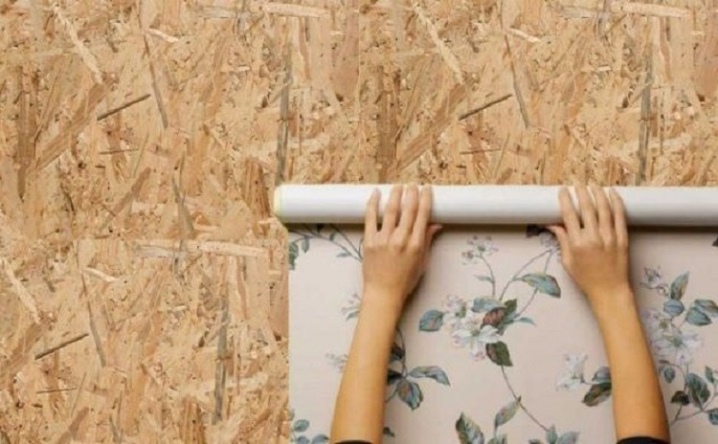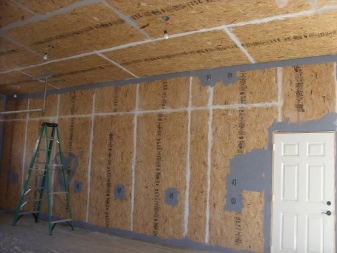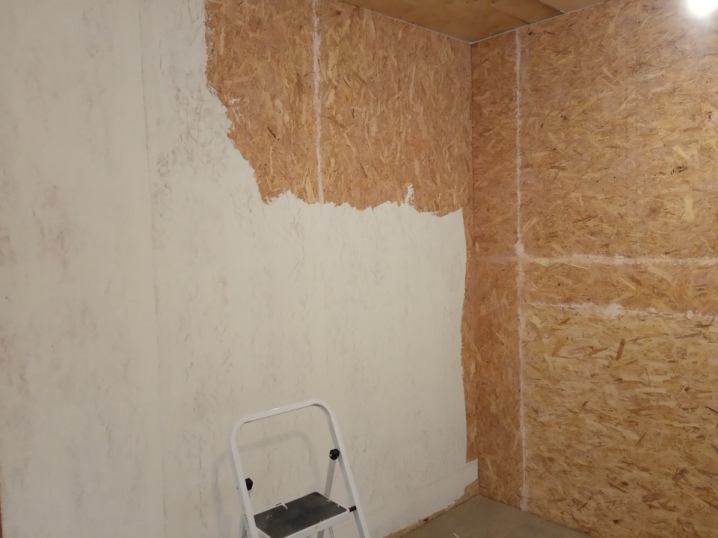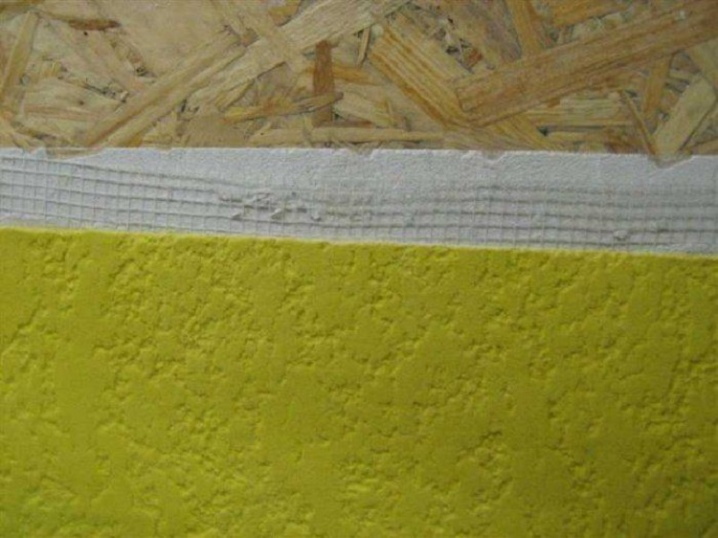We glue wallpaper on OSB plates

The question of whether it is possible to glue wallpaper on OSB-plates inside the house without putty is asked by many owners of individual housing. Wood-based panels are indeed increasingly used as a building material for the construction of load-bearing walls and partitions in the field of private housing construction, but their decorative finish causes certain difficulties. It is worth talking in more detail about how to cover the sheets, what preparation for gluing is necessary to obtain a perfectly flat surface, about the procedure for carrying out the work.

Can wallpaper be glued to an OSB board?
The creation of a stylish interior inside the house is most often carried out using wallpaper - an affordable material produced in rolls. They can have a different structure and base, and have attractive decorative properties. It's just that it is quite difficult to exactly fix the wallpaper on the OSB panel, and there are reasons for this.
Wood OSB-boards are a building material from woodworking waste, glued from chips with special compounds.


They allow you to easily and quickly cover large areas of wall openings, provide high moisture resistance due to the presence in the composition of impregnations based on wax and resins.
The material itself cannot be called too difficult to process. It only has some features that can significantly complicate the gluing of wallpaper.
- Inhomogeneity of the structure. In addition to the seams between the plates, which are difficult to perfectly match in all planes, the OSB surface itself does not look perfectly smooth either. It has pronounced irregularities, height differences, and the caps from the self-tapping screws under the wallpaper in the places where the modules are attached to the frame remain clearly visible.
- The appearance of greasy spots. The wax and resinous components of the impregnation with which the slabs are processed can ruin the expensive wall covering. A pre-untreated OSB-plate will gradually, with increasing temperature, release fatty substances onto its surface.
- The impossibility of applying glue, primer. Reduced adhesion of surfaces is directly related to the presence of moisture-resistant components in the impregnation and outer coating of wood-based panels. The wallpaper will simply not stick to such a surface, the work will have to be started anew.
- Swelling of the slab. Water-based liquid adhesives pose other threats as well. If the board is poorly processed, they can penetrate into its structure, causing the material to bulge. The surface of the walls will become uneven and require additional drying.

Most of these problems are solved by proper pre-treatment of the boards - first by mechanical grinding, and then by applying primers that increase adhesion.
Only in this sequence can the coating be made more convenient and safe for pasting, and its typical disadvantages can be eliminated.

Wallpaper selection
The modern industry produces many types of wallpaper. Each version of the canvases has its own advantages and disadvantages, features that have to be taken into account. Choosing the right material can be tricky. An overview of all the available wallpaper options suitable for application to the OSB board will help to cope with the task.
- Paper. The simplest and most affordable option is considered environmentally friendly. The drawing is applied by typographic method, it can be of any type.Two-layer paper wallpapers are also produced, usually with embossing and relief, they are more durable. This option is not suitable for rooms with high air humidity.

- Non-woven. Polymer-coated fiber-based material in rolls. It hides small irregularities of the walls well enough, is resistant to shrinkage, prevents the formation of dust, is strong and durable. In the presence of a vinyl layer in the composition, the material is suitable for coloring, but loses its main advantages.

- Vinyl. PVC-coated wallpaper has a volumetric relief structure, suitable for decorating non-residential premises. They do not have the ability to pass air, they require more effort when applied to walls.

- Textile. Expensive premium wallpapers created on a natural or synthetic basis. The composition usually uses rice paper, non-woven coating, as well as jute, silk, canvas. This eco-material also has disadvantages - it fade in the sun, absorbs dust, pasting is more complicated.

- Glass fiber. The material in rolls is made on the basis of fiberglass, the composition contains dolomite, soda, sand. Glass fiber can be painted, without decor, as well as finishing, with original weaving.

- Acrylic. They are two-layer, with non-woven or paper base and dusting. Foamed acrylic is cheaper than vinyl, it is more appreciated due to its lightness, environmental safety, but is inferior to analogues in terms of moisture resistance.

- Metallized. Two-layer wallpaper, in which aluminum foil acts as a decor. They can have different colors, relief, are used mainly in high-tech interiors.

- Liquid. This type of wallpaper is a mixture of cellulose and latex or acrylic. It is prepared before application, with the addition of coloring pigments and fillers to the liquid base. The compositions are easy to apply, dry quickly, and form original decorative coatings on the wall.

When choosing wallpaper, you should pay attention to their belonging to the same batch, especially for materials in which the pattern must be joined.
Products released at different times may not match in color and other characteristics.

How to glue without putty?
In a country house, it is quite possible to glue wallpaper directly onto plywood or OSB board. A simple finishing method does not guarantee a high aesthetics of the coating, but it is possible to prepare the walls in case of refusal from putty literally in one day, without waiting for complete drying. In this case, the gluing of the sheets happens like this.
- Preparing the walls. It is carried out by sealing the inter-joint voids formed during the installation of the slabs. In some cases, you can simply glue these areas with a masking tape of sufficient width. But it will be much safer to use an acrylic or silicone based sealant, preferably white.


- Leveling surfaces. Under the paper wallpaper, the top layer of OSB boards is removed with a special power tool - a grinder. For thick vinyl or non-woven materials, manual processing using sandpaper will be enough.

- Applying a primer. The optimal solution would be an acrylic mixture with a mineral filling, a short drying time. It is applied in 2 layers, sequentially, waiting for complete drying. When choosing a soil, it is better to give preference not to transparent, but to options painted in light colors. They will prepare a sufficient base for light wallpaper, will not allow a dark slab to visually distort their shade.

- Pasting the room with wallpaper. It is produced on a composition with the same base that was used for priming. It is worth paying attention - some types of wallpaper must be applied dry, the glue is applied to the wall, and not to the sheets themselves.

The absence of a full-fledged putty is suitable for the walls of premises that do not play an important aesthetic role.
In the case of voluminous, heavy wallpaper on a thick base, this factor also means quite little.
The material already well hides various elevation differences, coating defects.

How to stick with primer?
The classic method of pasting any wood-based panels is to pre-process them. Both for painting and for wallpaper, it is better to cover the walls of the room inside with a combination of primer and putty. In this case, wallpapering will not be a prerequisite - you can use liquid compounds or plaster. In any case, in order for the finish to hold, you need to cover the walls before applying it with special compounds. How to do it correctly is worth talking in more detail.

Choice of materials
There are several types of primers that are used for subsequent filling or other decorative surface treatments.
Adhesive
They are necessary to increase the ability of the material to adhere to other surfaces. In such a primer, quartz chips act as a filler, which ensures a reliable connection. The size of its fractions varies, best of all putties with a similar mineral composition are placed on such a coating.

Alkyd
They are used to prepare surfaces for painting or varnishing.
This type of primer provides additional moisture resistance, but has a strong, pungent odor, and is poorly eroded indoors.
Compositions are compatible only with paints on the same base.

Acrylic
Environmentally friendly option, characterized by fast drying, no pungent odor. A water-based primer may contain coloring agents, antifungals, and other additives. Suitable for self-gluing.
In addition to the primer, you will have to choose filler mixtures. They should be part of a group of tools adapted for working with wood. In this category, there are glue putty, oil glue and nitro, which are characterized by fast drying. It is strictly forbidden to finish the surface of the OSB-slab with mixtures of concrete, brick, gypsum.

Technology
Putty is the optimal solution for giving walls made of OSB boards with ideal smoothness and geometry. Like plaster, such compositions are able to smooth out small irregularities, in addition, they exclude the preservation of the pattern natural for wood chips panels. The order of work when using the putty will be as follows.
- Cleaning surfaces from dirt. Walls or partitions made of OSB-slabs are treated with grinding devices, removing the top layer.
- Padding. The choice should be made on an acrylic or adhesive base. The primer is applied twice, with complete drying of each layer.
- Reinforcement. A plaster mesh or its fiberglass counterpart is attached to the surface. A construction stapler will help to keep the reinforcing layer on the wall - the staples from it will cope with the task. Fastening is done in steps of up to 150 mm.
- Puttying. It is produced in layers. The first application is a rough one, after which the wall is processed with a metal spatula, then the coating is re-formed. This layer is also cleaned, polished, covered with primer. The wall is ready for further decoration.
- Wallpapering. When choosing a composition for fixing, you should choose options for adhesives with good adhesion to the putty or universal.



Finishing with putty compounds helps to ensure that the desired goal is achieved quickly enough: to get an even base for the wallpaper.
The rough coating eliminates direct contact of the adhesive with the board, preventing its deformation.
Besides, the presence of putty affects the noise insulation characteristics of the room, increasing them.

Working with liquid wallpaper
This type of finishing material is suitable for installation on E0 class boards that do not emit phenols and formaldehydes into the atmosphere. It is liquid wallpaper with minimal effort that can be used to decorate OSB-board walls. Recommendations for their use look like this.
- The surface of the panels is coated with a primer.Processing is carried out twice, it is better to choose acrylic compositions with antifungal additives.
- Mix for liquid wallpaper is diluted in a prepared container. If possible, it is worth purchasing a ready-made mixture in a plastic bucket.
- With the help of a trowel, liquid wallpaper is applied to the surface, distributed. Finishing is carried out from the corner of the room along the entire wall, it is not recommended to interrupt the work, since this can affect the aesthetics of the coating - the seams at the joint will be clearly visible.

As soon as all the walls are covered with a decorative layer of liquid wallpaper, you need to leave them to dry completely. Usually the manufacturer gives recommendations on its timing.
How to glue wallpaper on OSB plates, see below.













The comment was sent successfully.